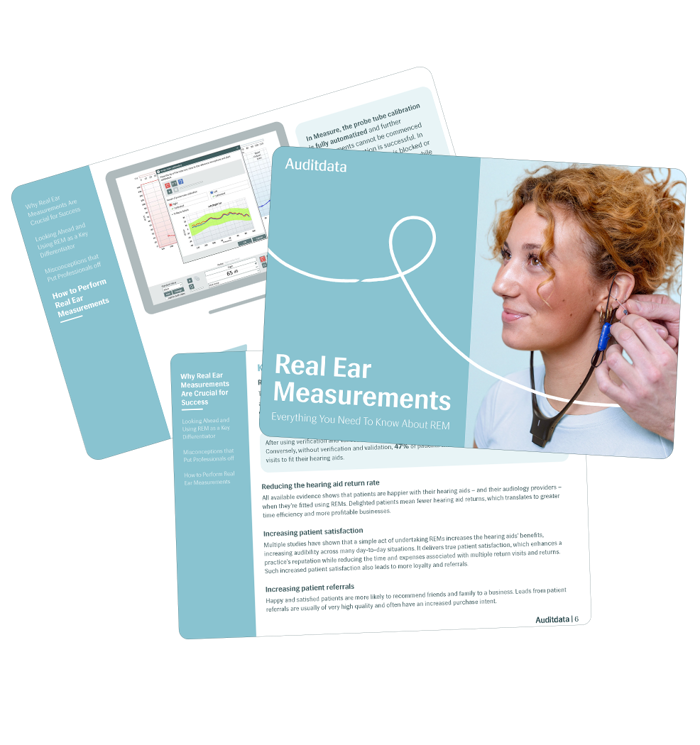
Co-Author: Leon-Vincent Fonai
People are frequently concerned about rising healthcare costs, including the high costs associated with hearing care. In the audiology space, patients are often frustrated by various stigmas surrounding hearing aids, including the perceived high price point of many hearing aids.
It's true that the prices of some hearing aids can be high, and certain insurance providers may not cover the full cost of the devices. For some people, the high price tag can be a barrier to getting hearing aids. But there are ways to make hearing aids more accessible and affordable for people with hearing loss – such as figuring out reimbursement options for those who qualify, and offering payment plans to those who don’t. Also, clinicians should remind their patients that hearing aids are available at a variety of price points, and help each customer find viable solutions within their budget comfort zone.
The Concern About Overpaying in Hearing Care

Approximately 28.8 million American adults need hearing aids, but only 16% of those adults between the ages of 20 and 69 that need hearing aids actually use them. Comparatively, most adults with vision problems (75%) use glasses or contact lenses to correct their vision, yet hearing aid use remains very low for people with hearing impairment. It’s also troubling that most people with hearing loss wait an average of 10 years before seeking treatment.
A common concern is that they won’t experience value for the money they’ve invested in the devices and they’ll overpay for hearing aids that will underdeliver.
There’s considerable information about hearing aids on the Internet – and significant marketing efforts by audiology clinics and hearing aid manufacturers – with most of it offering similar messaging. Everyone says their solutions are innovative and groundbreaking, promising amazing results, so how should your patients know which brands to trust?
Strategies for Hearing Care Professionals
It is in every hearing care professional's interest to help patients get the most value for their money and help them understand what solution would best suit their needs so they know exactly what they are paying for.
This also helps avoid situations when the patient feels like a clinician is just trying to upsell a solution they don't need or feel pressured to buy devices they don't feel comfortable with.
So, how do you make sure that your patients know they are not overpaying for hearing care?
1. Involve the Patient in the Decision-Making Process

As the hearing care professional, it's up to you to show each customer which hearing aid solution is most appropriate for their specific situation. If you think they’d benefit from certain features – like noise reduction or adaptive directionality of the microphones – explain why these features would be helpful – and why they’d be worth the extra money. Have each patient actively participate in the decision-making process. While you can share your suggestions and rationale, they will ultimately be the ones using (and paying for) the hearing aids, so they should see the value in their purchase.
Allow them to test some devices to experience the difference between higher and lower-priced models. Let them try the hearing aid for a few weeks – or up to a month or two – to get a good feel for the devices. Do measurements in the clinic, comparing a less expensive model to a higher-end one so your patients can experience the difference. If you do best practice fittings and the settings are adjusted properly, your patients will easily hear the differences between a low-end model and a more high-end device.
If you’re suggesting they get a higher-end model, explain why you’re recommending it. What does it provide that the other, less expensive options don’t offer? Why do you think the customer would appreciate these features – and why do you think it’s worth the extra money?
You should thoroughly explain each hearing aid solution and provide patients with comprehensive, useful information. This will ensure they feel confident in choosing the right option and comfortable with the associated costs, eliminating the fear of overpaying.
2. Provide Personalized Assessments

Provide tailored hearing assessments that consider the patient’s specific needs and lifestyle. This personalized approach ensures that patients only pay for what they truly need and can see the benefits of their hearing aids. This is a sustainable, trust-building, brand-building, long-term approach. Instead of earning a bit more money by upselling during an initial appointment, strengthen and grow your relationships to bring in more sales and referrals over the long term. The “ROI” of not upselling is way higher in the long run.
Therefore, think medium and long-term – not just short-term for bonus and commissions and reaching monthly goals of selling a certain number of devices. It’s smart to build long-term relationships. Start by learning about each patient’s needs. Use best practices for fitting – like REM – and fit patients right the first time. The patients likely would have great experiences and come back again. They would buy hearing aids, be loyal to that hearing practice, and refer their friends and family to that clinic. That’s a much better long-term way for that hearing clinic to be profitable.
Free Guide
Everything You Need to Know About Real Ear Measurements
This guide will explain why Real Ear Measurements are crucial in modern audiology and will dispel the misconceptions that may cause audiologists to avoid this test. We will also discuss the process for REMs, the benefits of this approach, and ideas to use REM in your clinics to set your business apart.

3. Be Transparent About Pricing and Financial Assistance Options

Depending on the brand, features, and level of technology, the average price of hearing aid devices is usually around $2,000 to $4,000. Hearing aids at the lower end of the price spectrum may cost less but will also have fewer features, tech upgrades, and customizable tools to help users hear better. Over-the-counter hearing aids may be less expensive options, but they aren’t appropriate solutions for everyone with hearing loss. OTC hearing aids, as of now, cannot be adequately adjusted or personalized to meet a client’s specific needs.
It's also imperative to understand each patient’s budget parameters – and to never assume what they’re willing to spend on hearing aids. Some people may be willing to spend more money for a high-end hearing aid that has more features and innovative technology.
Be transparent about costs, including a breakdown of costs for services and hearing aid options. Help patients figure out insurance and reimbursement plans. They’ll undoubtedly be relieved to have your staff assist them with the complex forms and rules around submissions and claims. Make hearing aids more accessible – and the costs more affordable – by offering monthly payment plans and other financial assistance options. Be clear that you prioritize patient health and hearing care – and you’re not in it “just to make a buck.”
The benefits of price transparency extend beyond just hearing aids’ price tags. For instance, better price transparency allows patients to avoid unexpected medical bills so they can better manage their healthcare budgets. Being upfront about costs in your communication with patients (and prospects) can help alleviate fears of overpaying and help build trust between patients and providers.
4. Outline Evidence-Based Recommendations

Use evidence-based practices to reassure patients that all your recommendations are rooted in solid research and tailored to their specific conditions. This helps demonstrate that you’re committed to helping them avoid paying unnecessary costs. While hearing care professionals are often worried about saying anything “too technical” during patient appointments, patients that might be considering higher end devices may be open to more evidence-based information about your recommendations.
For example, if a client has high-frequency hearing loss, then it makes sense to recommend a device that’s strong in transmitting those higher frequencies, which may be more expensive. In most cases, this can be easily explained by referring to the audiogram and explaining how a particular device is strong in transmitting those exact “sound regions” (or frequencies) that a patient is lacking. Don’t get into a technical “deep dive” with lots of industry jargon, but it’s OK to explain in broad terms how the higher-end devices work well to solve that patient’s needs, and why these more expensive solutions would be valuable in this situation.
5. Schedule Regular Check-ins and Adjustments

Be sure to schedule regular follow-up appointments with each patient to check, clean, maintain, and adjust their devices. This is essential to keep the devices operating optimally – and to ensure the customer gets the maximum value for their dollar.
It’s also best practice to conduct hearing screenings at regular intervals to determine whether there are any changes in the patient’s hearing health. These services are crucial to ensuring ongoing cost-effectiveness and care optimization.
Use audiology Practice Management Software, like Auditdata Manage, to automate these tasks and never forget to follow up with patients. Whether these are quick phone calls, scheduling appointments, or emails, Manage helps audiologists schedule tasks with ease and have an overview of these activities to ensure nothing slips through the cracks.
6. Real Patient Stories: Maximizing Value & Satisfaction

To maximize satisfaction and value, it’s important to define each patient’s hearing care goals. In many cases, their main goal is to enhance speech understanding. People often visit a hearing clinic because they’re frustrated that they can’t hear conversations, both professionally and socially, especially in situations with background noise. They may be embarrassed to ask people to repeat themselves because they can’t hear clearly. People with hearing loss often say that they want to understand speech with more reliability and less concentration.
In quiet surroundings, patients may not hear the difference between the least expensive and most expensive model. But in a very noisy environment, they will likely notice a difference between the two. A more expensive hearing aid can help people understand speech better in environments with ambient noise. This may be especially important to a patient that’s very sociable, spending considerable time in noisy restaurants or bars, listening to music or going to concerts, and/or participating in loud work meetings or university lectures.
Difficulty in understanding speech in noisy environments:
As an example, a middle-aged woman came to a hearing clinic with significant hearing loss. After a hearing screening, the audiologist recommended hearing aids, and asked about her goals for the devices. She explained that her main goal was to better understand speech in noisy environments, such as work meetings and in restaurants and bars. First, the woman tried less expensive hearing aids. Her audiologist said the lower-end, less expensive models would work fine, but wouldn’t be the ideal solution to meet her goals. With the lower-end devices, she would still need to focus hard to understand conversations, especially in crowded environments, like restaurants. When the patient tried the lower price model, she was bothered by background noise, and found that it was still quite difficult to hear conversations when there was ambient noise, especially when people spoke softly.
To compare, her audiologist asked her to try the higher-class, higher-priced hearing aids with more innovative technology and more advanced features. With these higher-end devices, she found that it was easier to understand speech – even soft voices – and she didn’t need to concentrate as intently on conversations. In the evenings, she could stay out longer without getting headaches or being tired. In this case, the customer decided that it was worth investing the money in the higher-end hearing aids, as she saw huge value in the features and functions that the more expensive devices offered.
A professional opera singer:
In another instance, a male customer came to a hearing clinic for hearing aids. As a professional opera singer, he wanted high-quality hearing aids because of the unique demands of his career. His audiologist explained that various hearing aid models have different quality levels, with several channels that users can select and change. His audiologist compared it to looking at a computer screen. If the computer screen is low quality, with low pixels, the user won’t be able to see an image clearly. Similarly, if a hearing aid is low quality, it will be challenging for the user to identify sounds because they won’t come across as “clean”.
While this opera singer’s hearing threshold was low because of his hearing loss, his perception was very trained due to the training he’d had over the course of his career. When he tried various hearing aids, he could hear even the most subtle differences between them. He chose the highest quality hearing aids – with the most channels and best sound resolution – so he could more clearly differentiate finer pitches, regulate more frequencies, etc., which he needed for his profession. Since sound quality was so essential to his daily life, he determined that the more expensive devices were worth the extra money and saw tremendous value in the higher-end option.
Other Blogs You Might Enjoy

What Do Your Hearing Aid Users Need?
If someone suspects they have hearing loss, they should see an audiologist for a hearing screening to determine whether they need hearing aids. But then what happens? This blog explains how to give your patients what they need for success with their hearing aids, such as setting proper expectations, providing care and maintenance tips for the devices, offering valuable tips before they buy, and providing ongoing aftercare.

How Auditdata Manage Helps You Deliver Best Care Experiences
Explore how Auditdata's Practice Management Software, Manage, enhances audiology care with advanced scheduling, personalized services, and effective aftercare. Learn to optimize every patient interaction to provide best care experiences to every patient at all times.

Customer vs. Patient – Does it Matter What You Call the People You Serve?
Should hearing clinics refer to the individuals they serve as patients or customers? Do these words matter? Could specific terminology make people feel better (or worse) about needing hearing aids? This blog explores the connotations associated with these terms.
Don't Miss Out On the Latest Insights On Audiology
Sign up today to receive exciting updates, tips, and the latest newsletters from Auditdata.
Resources
⭐️ Auditdata Manage - Practice Management Software
⭐️ Auditdata Measure - Portfolio of Audiological Equipment
⭐️ What is a Real Ear Measurement (REM)
⭐️ Over The Counter Hearing Aids – What Should You Do as a Practice Owner?
⭐️ Who should not get an over-the-counter hearing aid?
⭐️ Quick Statistics About Hearing, Balance, & Dizziness
⭐️ Audiologist survey highlights the need for industry change, and opens a box of challenges
⭐️ Paying for It: How Health Care Costs and Medical Debt Are Making Americans Sicker and Poorer
⭐️ Forbes Health Survey: Nearly Half Of People With Hearing Loss Believe There Is A Hearing Aid Stigma